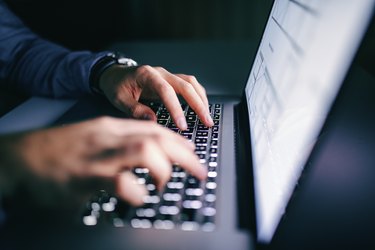
REGEDIT is the Windows Registry and it has the ability to lock the background wallpaper. Businesses frequently use this option to maintain a consistent and professional background across all computer screens. Shared computers may also have this feature enacted to prevent unnecessary wallpaper changes. Making the appropriate edits to the background registry key will ultimately unlock the wallpaper, making new changes possible again.
Check the Settings First
Video of the Day
Before jumping into the registry for edits, check to ensure the wallpaper settings are actually locked in place. Start the computer and right click the screen to open a list of options. Make sure to right click the screen only and not a desktop icon or folder. Choose Personalize and access the Background drop down list.
Video of the Day
Select a new photo from the available files for the background. You can also add new photos to the hard drive and choose from personal files for a completely unique and custom wallpaper option. Choose between the tile, fill, stretch, fit and center options to set the new wallpaper and save the changes to make the new background take effect.
If the wallpaper settings will not allow changes, exit from the panel and prepare to edit the registry. After completing the edits, making changes to the wallpaper is easy and you will not experience another lockout unless the registry is changed again.
REGEDIT Wallpaper Unlock
Open the Registry Editor by typing REGEDIT in the search bar on the computer. Click Start and then Run to launch a text box. Enter REGEDIT in the editor and it will generate a list of options. Click to expand the option labeled HKEY_CURRENT_USER\Software\Microsoft\Windows\CurrentVersion\Policies to access the default policy settings. The default allows for changes to the wallpaper by any user with access to the computer.
Look under "Policies" for an ActiveDesktop label and delete this if the setting exists. If the setting does not exist, you may also find a label for Wallpaper or NoDispBackgroundPage under the policies system settings. To access the policies system settings, use the same process but expand the option with \System as the final label in the sequence.
Delete the Wallpaper label if found or click the NoDispBackgroundPage option and set to a numerical 0 to remove the lock. Return to the home screen and attempt to change the wallpaper at this point. The ability to open and adjust the settings should be seamless at this point, leaving the option change to preset wallpaper designs or to use custom graphics and photos uploaded to the computer.
Background Registry Key File
One very simple option for editing the registry is the utilization of an edit file that changes the desktop background registry in a matter of seconds. This process requires zero editing within the actual registry and is very easy to execute. The registry edit file does require allowing permissions to complete the almost automated fix for the locked wallpaper issue but one simple click will change the registry to allow for new wallpaper.
Access any edit registry site with a fixwallpaper.reg file available. Tech-pro.net has one readily available at no cost (see Resources) but others are available through a basic web search. Right click the file and save to your computer.
Access the newly saved file and double click to activate. When prompted, click Yes to allow for changes to the registry. Once complete, the wallpaper is unlocked and ready for editing or new custom photos and formatting. This works to change wallpaper in Windows 10 with regedit, and in earlier versions of Windows too.